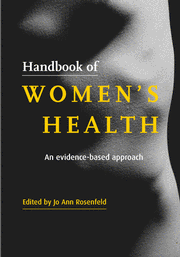Book contents
- Frontmatter
- Contents
- List of contributors
- Common abbreviations used in the text
- Normal blood values in women and during pregnancy
- Introduction
- 1 Singular health care of women
- Preventive care
- Psychosocial health
- Sexuality
- 9 Sexuality and sexual dysfunction through the life cycle
- 10 Contraception
- 11 Infertility and adoption
- 12 Special issues with lesbian patients
- 13 Medical care in pregnancy: common preconception and antepartum issues
- Genitourinary medicine
- Breast disorders
- Psychological disorders
- Common medical problems
- Index
10 - Contraception
Published online by Cambridge University Press: 28 October 2009
- Frontmatter
- Contents
- List of contributors
- Common abbreviations used in the text
- Normal blood values in women and during pregnancy
- Introduction
- 1 Singular health care of women
- Preventive care
- Psychosocial health
- Sexuality
- 9 Sexuality and sexual dysfunction through the life cycle
- 10 Contraception
- 11 Infertility and adoption
- 12 Special issues with lesbian patients
- 13 Medical care in pregnancy: common preconception and antepartum issues
- Genitourinary medicine
- Breast disorders
- Psychological disorders
- Common medical problems
- Index
Summary
Contraception is an inherent part of good health care and good preventive care for women. Fertility is not a disease, and therefore, contraception is not a purely medical concern but an area for collaborative care in which the woman asks for information and help in planning her pregnancies.
Introduction
The “modern” birth control era began in the USA in 1912 with Margaret Sanger's programs. Table 10.1 provides a historical timeline of contraception in the USA.
The proportion of reproductive age women using contraception and the percentage of women using contraception at “first intercourse” continue to increase. The percentage of sexually active women not using contraception has declined among most major ethnic groups including African-Americans, Hispanics, and whites.
Despite these successes, nearly half of the over six million pregnancies in the USA each year are “unintended”. Half of the unintended pregnancies occur in the three million women who do not use contraception. The remaining halfof unintended pregnancies occurs in the 39 million women who use contraception but experience a method failure.
Women who do not use contraception and have an unintended pregnancy are equally as likely to have a therapeutic abortion as to continue the pregnancy and have a live birth. Effective contraception for more women would help to reduce the number of abortions.
[…]
- Type
- Chapter
- Information
- Handbook of Women's HealthAn Evidence-Based Approach, pp. 153 - 183Publisher: Cambridge University PressPrint publication year: 2001
- 1
- Cited by

